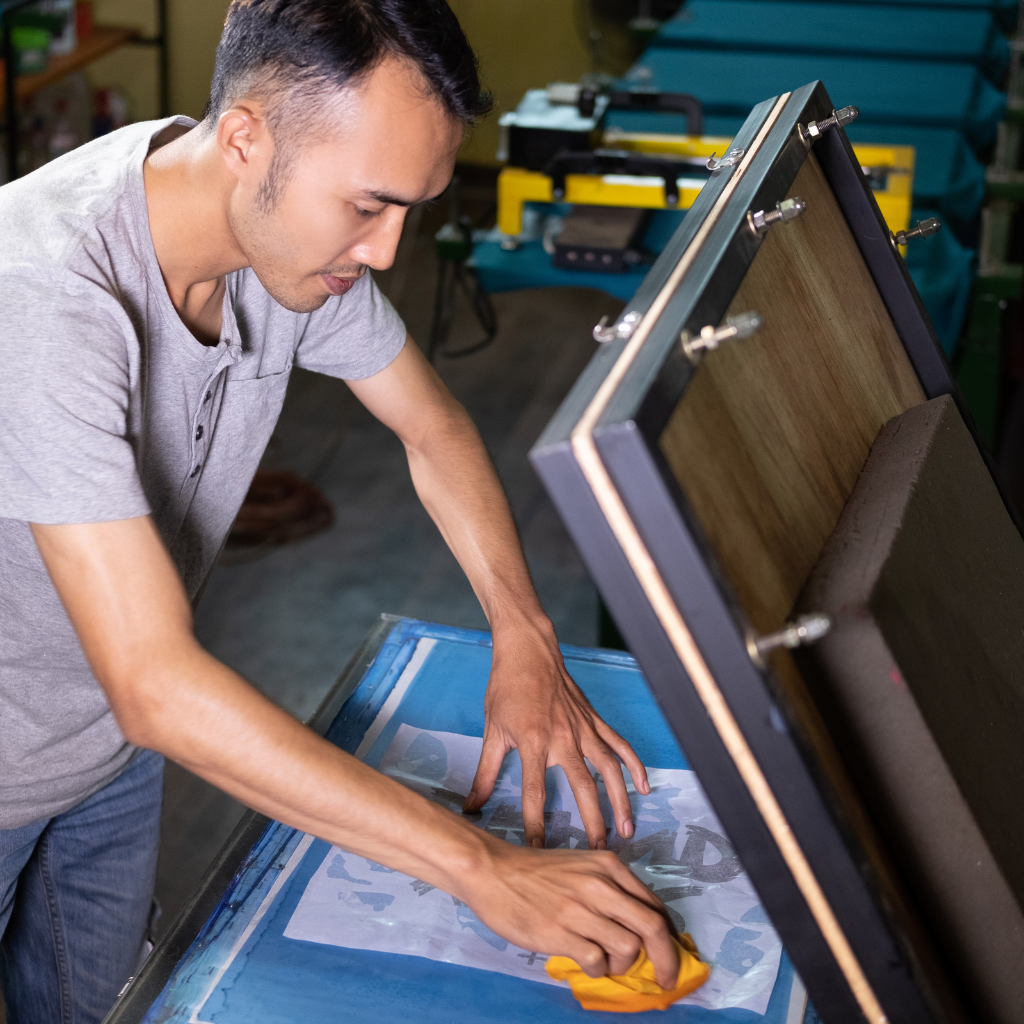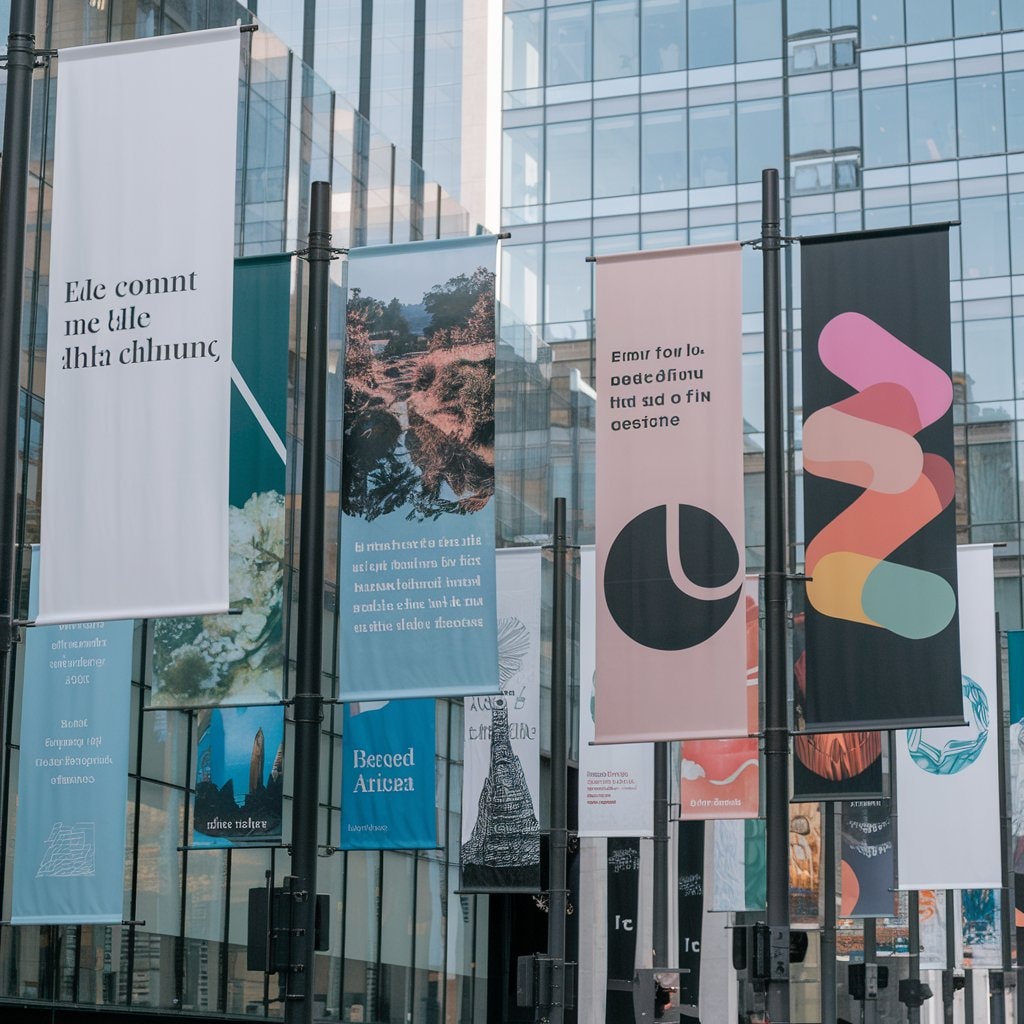Fabric posters fuse robust textiles with specialized printing techniques, including acrylic paint, to yield durable and vivid displays. The process involves selecting the ideal fabric, such as polyester, for its ink receptivity, followed by applying fabric-specific ink that penetrates deeply, ensuring color vibrancy and longevity. Heat-setting the ink fixes the colors, enhancing their resistance to fading. For an extensive exploration of achieving high-quality results and creating professional indoor signage,, more thorough guidance on choosing materials and techniques is available to empower creators and marketers further.
Key Takeaways
- Select high-thread-count fabrics like polyester for optimal ink absorption and resolution.
- Use specialized fabric paint and acrylic mediums to ensure deep color penetration and durability.
- Implement heat setting techniques post-printing to enhance ink durability and prevent fading.
- Optimize images at a high resolution (300 dpi) and use PDF format to maintain design integrity.
- Employ consistent and contrasting color schemes to enhance readability and visual impact.
What Are Fabric Posters?
Fabric posters are crafted from durable, lightweight materials that contrast sharply with traditional paper mediums and clothes. And offer unique textural qualities.
These posters employ specialized printing techniques that can integrate acrylic paints, enhancing vibrancy and texture depth.
Remarkably, their foldable nature guarantees ease of transportation and storage, making them particularly advantageous for frequent usage in various settings.
Understanding Fabric Material
While traditional posters are typically printed on paper, fabric posters utilize a variety of textiles such as polyester, satin, or nylon, offering a durable and versatile alternative.
Fabric posters, made primarily from high-quality fabric materials, are gaining popularity for both personal and professional use thanks to their unique qualities that make them ideal for vibrant, long-lasting displays.
- Polyester Fabric: Known for its strength and wrinkle-free properties, polyester guarantees that fabric posters remain crisp and smooth.
- Print Quality: The tight weave of textile materials facilitates high-resolution ink absorption, enhancing the sharpness and vibrancy of images.
- Fabric Presentation: Textile posters can be easily transported and hung without creasing, maintaining an elegant appearance.
- Ink Compatibility: Specialized inks are used to prevent fading and maintain color integrity over time.
Comparison with Paper Posters and Acrylic Paint Usage
In comparing fabric posters with traditional paper posters, it becomes apparent that each medium offers distinct advantages and limitations.
Fabric posters, printed on durable, crease-resistant material, are particularly suited for vibrant, high-quality displays. The fabric absorbs inks deeply, allowing for rich, saturated colors that are enhanced by UV protection, thereby prolonging the vibrancy of the artwork against fading.
Conversely, paper posters, while less expensive and easier for high-volume print runs, lack the durability and resistance to environmental factors that fabric offers.
Additionally, the use of acrylic paint on fabric posters can further enhance their aesthetic appeal, creating a textured, dynamic visual effect that paper cannot replicate, making fabric posters a more robust and versatile option in many scenarios.
Advantages of Foldable Fabric Posters
Given their unique construction, foldable fabric posters offer several practical advantages over their more rigid counterparts:
- Transport Convenience: Unlike traditional posters that require bulky poster tubes, foldable fabric can be easily folded into compact, manageable sizes, fitting snugly into luggage or briefcases, making them ideal for travelers and researchers.
- Crisp Images: Fabric posters maintain the integrity of crisp, vibrant images even after being folded, unlike paper, which might crease or tear.
- Ease of Mounting: These posters can be quickly mounted on various surfaces without the need for extensive setups, accommodating both temporary and permanent decoration needs.
- Versatility in Use: Available in standard sizes, fabric posters serve not only as research posters but also as decorative pieces, efficiently adapting to diverse settings.
How Does Fabric Poster Printing Work?
Fabric poster printing begins with the meticulous selection of suitable fabric, where qualities such as thread count, weave type, and material absorbency dictate the sharpness and vibrancy of the final print.
The process involves applying specialized fabric paint tailored for compatibility with the chosen textile, ensuring that the colors penetrate deeply and evenly.
To finalize the creation, heat setting techniques are employed to cure the ink, an essential step that enhances the durability and colorfastness of the poster.

The Print Process Explained Using Your Fabric Paint
Exploring the intricacies of fabric poster printing reveals a fascinating blend of art and technology, particularly when using one’s fabric paint. This process involves a careful preparation and application method:
- Preparation of Paints: Mix poster paint with an acrylic medium to adjust the thickness and flow. The acrylic medium acts as a binder and helps the pigments adhere better to the fabric.
- Incorporation of Fabric Medium: Adding fabric medium to the paint mixture helps soften the texture, ensuring the paint remains flexible and doesn’t crack.
- Application Technique: Use sponges or brushes for an even application, preserving the details of the artwork.
- Heat Setting: After application, the fabric is often heat-set to cure the paint, ensuring durability and vibrancy of colors.
Choosing the Right Fabric for Your Poster
While the process of fabric poster printing incorporates various complex steps, selecting the appropriate fabric serves as the foundational decision that greatly impacts the final product’s quality and appearance.
When fabric posters are printed, the type of cloth chosen is essential. Premium fabrics guarantee durability and enhanced color vibrancy, ideal for indoor presentation posters where lighting and visual impact are key.
The layout of your poster should influence the fabric’s width to avoid unnecessary seams that could disrupt the design.
On the product page, customers can upload their original file, allowing precise adjustments to the fabric dimensions and quality, confirming that the final print truly reflects the intended aesthetic and professional standards.
Ensuring High-Quality Prints with Proper Heat Set Techniques
To guarantee the vibrancy and longevity of fabric posters, the application of proper heat set techniques and set fabric paint is essential during the printing process.
Implementing these procedures assures that the ink firmly adheres to the fabric, enhancing both the quality and durability of the print.
- Temperature Control: Utilize a medium heat setting on an iron to prevent scorching the fabric while assuring effective ink fixation.
- Steam vs. Dry: Opt for a dry heat method to avoid ink diffusion unless the specific ink or fabric benefits from a slight steam.
- Reverse Ironing: Iron on the reverse side of the printed fabric to protect the ink surface and improve the consistency of heat application.
- Hanging to Dry: After heat setting, always hang the garment to allow it to dry naturally, preserving the print’s integrity.
How to Design a Fabric Poster for a Conference?
Designing a fabric poster for a conference requires adherence to specific layouts and design guidelines to guarantee visual appeal and legibility from a distance.
High-resolution images must be optimized for fabric printing to maintain sharpness and color accuracy, a vital step given the unique texture and absorption properties of fabric materials.
Additionally, selecting the correct file format, particularly PDF, is essential for preserving the integrity of the design when transferred to fabric print media.
Essential Guidelines for Layout and Design
Creating an effective layout for a fabric poster intended for a conference involves meticulous attention to visual hierarchy, readability, and aesthetic appeal.
For designers aiming to maximize the impact of their fabric posters, certain key elements must be strategically considered:
- Visual Hierarchy: Arrange content to guide the viewer’s eye through the poster, prioritizing key information like the conference title, date, and logo.
- Readability: Choose clear, legible fonts and a color scheme that contrasts well against the fabric background.
- Aesthetic Appeal: Incorporate high-quality images and consistent brand colors to enhance the professional appearance.
- Design Specification: Adhere to specific dimensions and resolution requirements to guarantee the final print is sharp and aligned correctly on the fabric.
Optimizing Resolution and Image Quality for Fabric Paint
After establishing a strong layout and design, the next step in crafting a high-quality fabric poster for a conference is optimizing resolution and image quality.
For fabric posters, the choice of resolution is essential. A higher resolution guarantees that fine details are preserved, especially when working with intricate designs and acrylics. Typically, a resolution of 300 dpi (dots per inch) is recommended for crisp, clear images.
When selecting paints, consider the consistency; thick acrylics may not penetrate thin fabrics effectively, leading to a patchy appearance. Conversely, thinner paints might spread too much on thicker fabrics.
Employing a suitable brush and technique can greatly influence how the paint adheres to the fabric surface, enhancing the overall image quality of the print
How to Prepare Your Fabric Poster for Delivery?
When preparing a fabric poster for delivery, it is essential to master the art of folding to minimize creases and guarantee the poster remains pristine upon arrival.
Ideal folding techniques, coupled with the strategic use of protective materials, can effectively safeguard against wrinkles.
Additionally, selecting the right delivery service and understanding their timing constraints are critical steps to guarantee the timely and safe arrival of your fabric poster.
Folding and Transport Tips
Preparing a fabric poster for delivery requires meticulous attention to folding and packaging to ascertain it arrives in pristine condition. Proper handling guarantees the longevity of the print, preventing wear and cracking that can occur during transport.
Here are some essential tips:
- Pre-Wash: Always pre-wash the fabric to eliminate residues that might affect the folding process.
- Folding Technique: Use a gentle, uniform method to fold the fabric, avoiding sharp creases that can damage the print.
- Protective Layering: Place a soft, acid-free tissue between folds and wrap the poster in a clean, non-abrasive fabric.
- Cardboard Support: Insert a sturdy piece of cardboard to support the poster, and seal the package securely to prevent shifting during transport.
Preventing Crease and Wrinkles
Ensuring that fabric posters remain free from creases and wrinkles during delivery demands a methodical approach to both preparation and packaging. To prevent damage to the high-quality print, one should first consider the material of the fabric, akin to selecting a fine garment or shirt.
Lightweight fabrics are more prone to wrinkling; consequently, opting for a more robust textile can be advantageous. Once the poster is printed, it should be rolled rather than folded. Rolling the fabric around a sturdy cardboard tube prevents creases by distributing tension evenly across the poster.
Additionally, wrapping the rolled poster in plastic before placing it in a shipping tube, much like protecting a garment inside, adds a layer of protection against moisture and external pressures that could mar the fabric’s pristine surface.
Understanding Delivery Options and Times
How can one optimize the delivery process of fabric posters to guarantee they arrive in perfect condition?
When it comes to fabric posters, ensuring they maintain their high-quality print during transit requires meticulous preparation and understanding of various delivery options and times.
Consider these steps:
- Choose Robust Packaging: Utilize hard tubes or high-grade poly mailers that safeguard against moisture and creases.
- Include Handling Instructions: Clearly mark the package with handling instructions to prevent mishandling.
- Select Appropriate Delivery Service: Choose a delivery service that offers reliable tracking and expedited options to control delivery times.
- Plan Ahead: For same-day fabric poster printing, coordinate the printing and shipping schedules meticulously to avoid delays.
Proper planning and packaging are essential in maintaining the integrity of the fabric poster from purchase to delivery.
How to Display Fabric Posters Effectively?
Displaying fabric posters effectively involves several key techniques that enhance their visual impact and preserve their quality.
Mounting methods must be carefully selected to guarantee both security and ease of viewing, considering factors like frame compatibility and wall surface.
Additionally, the choice of backdrop and decorative elements around the poster can greatly influence the viewer’s experience, particularly in an exhibition setup where lighting and spatial arrangements play vital roles.

Methods for Mounting Your Poster
Several innovative methods are available for mounting fabric posters, each tailored to enhance the visual appeal and preserve the material’s integrity.
- Stretch Frames: Secure the fabric poster onto a stretcher frame similar to those used for canvas art. This method pulls the fabric taut, eliminating wrinkles and ensuring a smooth, professional appearance.
- Magnetic Hanging Strips: Utilize magnetic strips that attach to both the wall and the back of the poster. This allows for easy adjustments and removal without damaging the fabric.
- Adhesive Velcro: Apply Velcro strips to the poster and corresponding wall areas, offering a simple solution for temporary displays and easy relocation.
- Dowel Rod and Rope: Sew a casing at the top and bottom of the poster to insert dowel rods, then hang it using decorative rope, combining functionality with a rustic aesthetic.
Choosing the Right Decoration and Backdrop
After selecting an appropriate method for mounting fabric posters, the next step involves determining the ideal decoration and backdrop to showcase these pieces effectively.
Choosing a fine, textured fabric as a backdrop can prevent the poster’s own fabric paint from flaking or allowing color to seep through. For a fun yet functional approach, using a hair dryer on a low setting can help set the paint, ensuring the colors remain vibrant and durable.
It’s generally essential to hand wash these backdrops to maintain their integrity, especially in settings like medical research conferences where pristine presentation is vital.
The backdrop should complement the poster’s theme, enhancing its visibility and impact without overshadowing the detailed content it carries. In professional environments, especially offices and co-working spaces, incorporating creative workspace wall designs alongside fabric posters can elevate the overall ambiance, promote brand identity, and spark inspiration.
Tips for Exhibition Setups
When setting up an exhibition to showcase fabric posters, precise attention to lighting and spacing is essential. Effective display can greatly enhance the visual impact and audience engagement with the artwork.
To optimize the setup, consider the following:
- Lighting Conditions: Use diffused, indirect lighting to prevent glare and shadows, enhancing the colors and details of the fabric posters.
- Spacing Between Posters: Provide adequate space between each poster to allow individual pieces to be appreciated without visual clutter.
- Mounting Techniques: Choose non-invasive mounting solutions that preserve the integrity of the fabric, such as magnetic or clip-based systems.
- Viewer Flow: Arrange the posters in a logical sequence that guides the viewer through the exhibition, facilitating an intuitive and enriching experience.
Conclusion
To summarize, fabric posters represent a sophisticated blend of functionality and aesthetic appeal, ideal for dynamic display settings such as conferences. The process involves careful design and digital printing techniques that guarantee vivid colors and sharp details on durable textiles. Preparing and delivering these posters requires meticulous folding and packaging methods to maintain quality. When displayed, strategic placement and secure mounting maximize visibility and impact, making fabric posters a compelling choice for effective communication and professional presentation.


